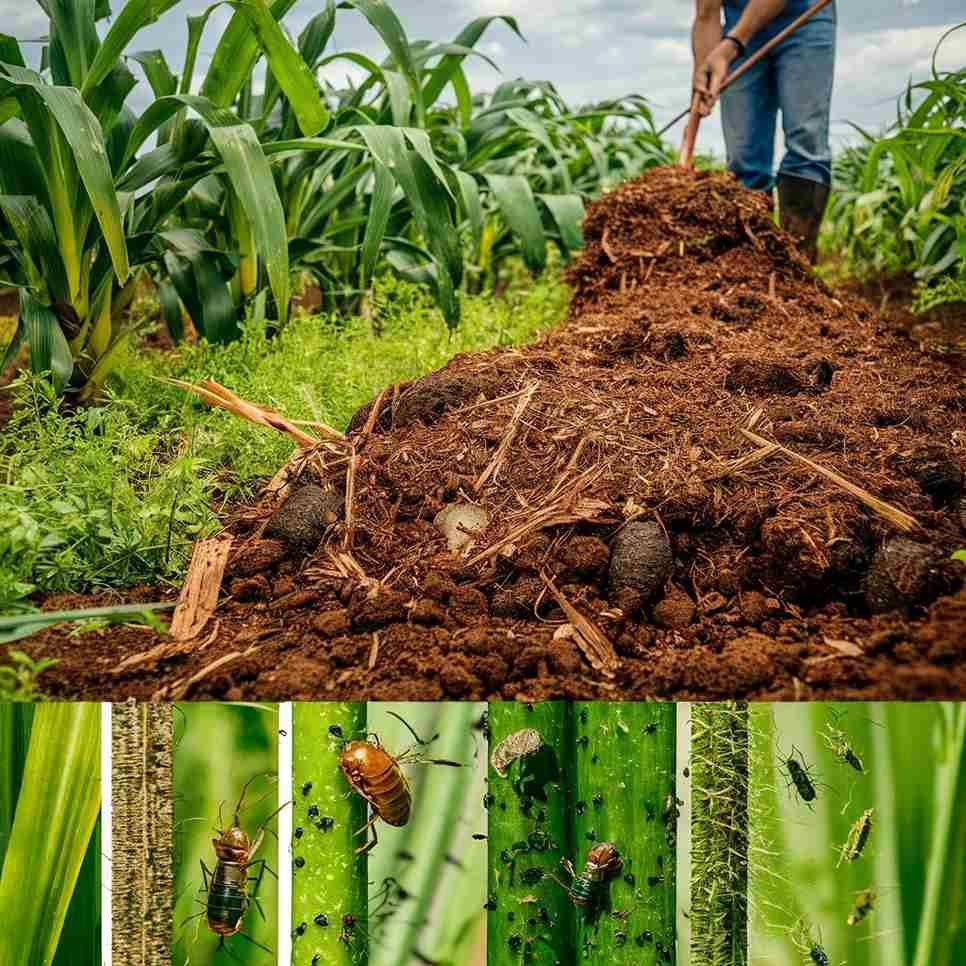Specifically in Nepal, sustainable agriculture relies heavily on green manuring, bio-gas, bio-fertilizers, and organic manure. Plant and animal wastes that have broken down into organic manure increase the fertility of the soil. Green manuring is the process of growing and adding particular plants to improve soil health, whereas bio-fertilizers contain beneficial microorganisms that increase nutrient availability. An environmentally friendly and renewable energy source, bio-gas is created when organic waste is anaerobically digested. In rural Nepal, these methods help to improve living conditions, manage waste effectively, and promote sustainable farming.
Table of Contents
Introduction to Organic Manure

The natural fertilizer known as organic manure, which is produced when plant and animal wastes break down, is essential to sustainable agriculture. Organic manure is derived from various materials including crop residues, animal waste, compost, and vermicompost. It enhances the soil’s structure and fertility by adding vital nutrients. Organic manure, as opposed to chemical fertilizers, improves the microbial activity, organic matter content, and water retention of soil over the long term. Its use encourages resilient agricultural systems, lessens dependency on artificial inputs, and supports ecologically friendly farming methods. Organic manure helps maintain sustainable land management practices and boosts agricultural productivity by repurposing organic waste into beneficial soil amendments.
Source
Organic manure comes from natural sources and is essential to farming methods that are sustainable. Compost, crop leftovers, and animal dung are the main sources of organic manure. Cow dung, a rich source of nutrients necessary for soil fertility, is widely used in traditional agricultural practices in Nepal. Furthermore, green manure and crop residues are frequently utilized to improve soil health. Common sources include:
- Animal waste: Goat and sheep dung, chicken litter, and cow dung.
- Plant Waste Products: Grass clippings, leaves, green manure, crop leftovers.
- Compost: Organic matter that has broken down, such as garden and kitchen scraps.
- Vermicompost: Organic matter broken down with the help of earthworms.
Classification
Organic manure can be classified into several categories, each contributing uniquely to soil enrichment. Farmyard manure (FYM), green manure, and compost manure are the predominant types. Organic manure can be classified into the following categories:
- Farmyard Manure (FYM): Consists of urine, animal dung, litter, and leftover feed.
- Green manure: Plants raised especially to replenish the soil with organic matter in order to increase fertility.
- Compost: Organic matter that has broken down and is created by either anaerobic or aerobic processes.
- Vermicompost: Made with earthworms, which quicken and improve compost’s decomposition.
Preparation
The preparation of organic manure is a meticulous process that ensures the optimal release of nutrients.
1. Farmyard Manure (FYM):
- Gather bedding materials, urine, and animal dung.
- Allow it to decompose in a pit or heap for several months.
- To guarantee uniform breakdown, rotate the pile from time to time.
2. Compost:
- Gather waste materials that are organic.
- Arrange them in a compost pile or bin using alternating layers of brown (rich in carbon) and green (rich in nitrogen) materials.
- Turn the pile frequently to keep it moist and to allow air to enter.
- When the compost is crumbly, dark, and smells earthy, it is ready.
3. Vermicompost:
- Fill a container with bedding materials, such as torn newspaper.
- Include garden and kitchen waste.
- Present earthworms, such as Eisenia fetida.
- Retain moisture and feed frequently.
- After a few months, harvest the vermicompost by taking the worms out of the compost.
4. Green Manure:
- Choose the right crops to use as green manure (such as clover or legumes).
- Plant seeds and watch them grow.
- Before the green plants reach full maturity, incorporate them into the soil.
Bio-Fertilizer and Green Manuring
Bio-fertilizers, which increase soil fertility through organic means, are essential to sustainable agriculture. These biological products are made up of living microorganisms that increase plant growth and nutrient availability when applied to seeds, plant surfaces, or soil. Phosphate Solubilizing Bacteria (PSB), Azotobacter, and Rhizobium are a few of the most widely utilized bio-fertilizers.

Legume and rhizobium bacteria work together symbiotically to fix atmospheric nitrogen into a form that is easily absorbed by plants. By doing this, the soil’s nitrogen content is increased and the need for chemical fertilizers is decreased. In a similar vein, the free-living nitrogen-fixing bacterium Azotobacter greatly enhances soil health by converting atmospheric nitrogen into ammonia that plants can readily use. In contrast, bacteria that solubilize phosphates increase the availability of phosphorus by changing insoluble phosphates into soluble ones. Phosphorus is an essential nutrient that promotes root growth and general plant vigor, which makes it critical.
Green manuring is another essential practice that complements the use of bio-fertilizers. In order to increase the soil’s organic content and structure, specific plants—legumes, for example—are often added to it. Alfalfa, clover, and different types of vetch are common crops grown with green manure. In order to keep the soil fertile, control weed growth, and stop soil erosion, these plants are planted and then tilled back into the ground. Green manure breaks down into organic matter that improves the soil’s ability to hold water and serves as a home for helpful microorganisms.
Bio-Gas and its Importance in Nepal
Anaerobic digestion of organic materials, such as animal dung and agricultural waste, results in the production of bio-gas, a renewable energy source. In this process, organic matter is broken down by bacteria in the absence of oxygen, producing digestate rich in nutrients and gas that is high in methane. The production of biogas has become a feasible approach for waste management and energy generation in Nepal, a country with a substantial agrarian population.
Importance in Nepal
- Energy Source: Reduces reliance on firewood and fossil fuels by offering a sustainable and renewable energy source for lighting and cooking.
- Environmental Benefits: Burning biomass lowers indoor air pollution, greenhouse gas emissions, and deforestation.
- Waste Management: Reduces pollution in the environment by managing agricultural and animal waste effectively.
- Economic Benefits: Reduces household energy costs and creates jobs in the building and maintenance of biogas plants.
- Health Benefits: Lowers respiratory ailments linked to indoor air pollution from conventional cooking techniques.
- Benefits for Agriculture: Creates a byproduct that is rich in nutrients and can be utilized as an excellent organic fertilizer.
Promotion in Nepal
- Government programs and financial aid for the construction of biogas plants.
- Education and awareness campaigns to inform households and farmers about the advantages of biogas.
- Investigation and advancement to enhance bio-gas technology and its adjustment to regional circumstances.
In conclusion, bio-fertilizers, green manuring, organic manure, and biogas generation are essential elements of Nepal’s rural development and sustainable agriculture. They aid in increasing soil fertility, controlling waste, lessening the negative effects on the environment, and raising rural residents’ standard of living.
Frequently Asked Question(FAQ)
What is organic manure?
An organic manure is a naturally occurring fertilizer that is produced by animal and plant waste breaking down. It increases the fertility and structure of the soil while enriching it with vital nutrients.
What are the sources of organic manure?
Animal waste (cattle dung, poultry litter), plant residues (crop residues, green manure), compost (decomposed organic matter), and vermicompost (made with earthworms) are examples of common sources.
Related Articles

